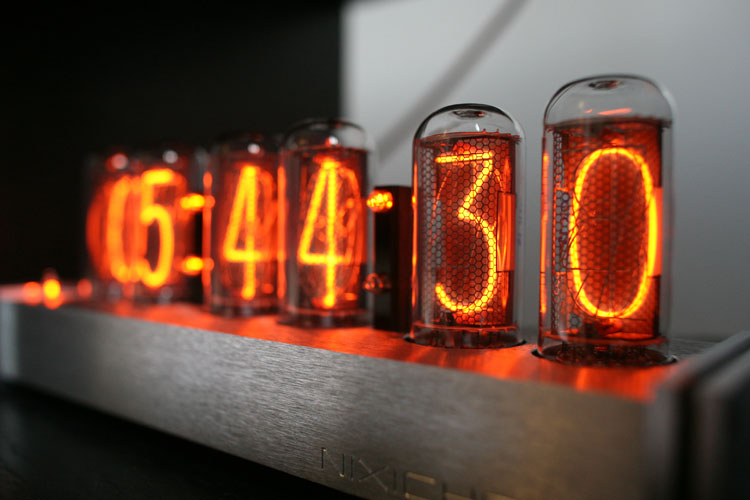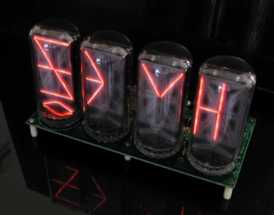 |
Pardon
Me, Got the Time?
By Michael
Jay Geier
If you're an
engineer, your reply just might be, "Sure. You want that in binary?" Let's
face it, we tech types love clocks: LED, LCD, nixie, analog, GPS, radio
synchronized, even atomic. So IEEE Spectrum picked out a few gems
for your mantelpiece.
Take the Powers
of 2 clock from Realnerds (http://www.realnerds.com).
This clock will confound your nontechie friends while bringing a smile
of recognition to every programmer you know. No numbers here, just six
columns of LEDs, one column for each digit marking the hours, minutes,
and seconds, in blue (US $22.98) or red ($19).
As the seconds
tick off, the resulting pattern is enigmatic to anyone not familiar with
the code, which is binary-coded decimal. Read upward from the bottom of
a column, each LED represents 1, 2, 4, or 8. Time is read by adding (quickly)
the values of the lighted bits in each column. For example, the time on
the clock in the photo is 02:26:52. (The columns representing the tens
of minutes and hours need only reach 5, so 3 bits are sufficient. Likewise,
the first column needs 2 bits to represent 0, 1, or 2.)
It sounds baffling
but really isn't; my nontechie brother, who didn't even realize the thing
was a clock when he first saw it, got the hang of reading it in about 2
minutes and fell in love with it. The constantly changing pattern is mesmerizing,
though it can be distracting because of the high brightness of the LEDs.
It's a nice effect on a bookshelf in the den, but you probably won't want
to put this clock over your TV or anywhere in your bedroom. Still, it's
a cool clock.
If you're over
40, you probably remember nixie tubes, the pre-LED vacuum-tube readout
in wide use through the 1960s [see "New
Life for Nixies," Spectrum, June 2002]. With their neon-orange
glow and rounded, fully formed digits, nixies have an elegant look. Though
the tubes are no longer being made, surplus stocks permit the manufacture
of small quantities of nixie products.
Jeff Thomas
at Resonant Instruments LLC, in Mesa, Ariz., blends modern technology with
the nixie tube, with his NixiChron clock ($499; clockpage.html)
[see photo below]. Its ground and anodized metal base and bare tubes are
geek-chic, and the tiny Global Positioning System receiver that plugs into
the back keeps it accurate anywhere in the world. An included extension
cable lets you put the GPS module on your windowsill or even outside, but
I had no trouble picking up the satellite signals at my desk.

The clock's
menu offers all kinds of options, including a scrolling display of temperature
from a built-in thermometer and latitude/longitude coordinates. It's a
truly classy timepiece and my favorite of the bunch.
Another, but
very different, nixie clock is the GeekKlok from Zetalink Technology (http://www.zetalink.biz)
.

The nixies used
in this kit are segmented in 16 straight lines, so various fonts and simple
animations can be presented. The effect can be bizarre, with some fonts
(including Klingon from "Star Trek"!) unreadable to anything but the trained
eye. An internal crystal oscillator provides the time base, with correction
once a day from the ac power line's frequency.
The clock also
accepts a 1-pulse-per-second signal from an external timing generator,
for time accuracy as good as that of the source. At $99, the kit is a bargain,
though the nixie tubes are extra and come from a different supplier, to
which Zetalink refers you.
Still in the
retro-look department, the Scope Clock from David Forbes presents the time
on the face of an oscilloscope tube. Each number is drawn as a series of
arcs on the 7.6-centimeter-diameter screen. Depending on the type of external
case you select‹it comes in plastic or hardwood‹prices for assembled versions
range from $350 to $495, with kits available for $50 less.
My review unit's
clear plastic case is very sci-fi and makes me wish I had a spark generator
to put next to it, for the full 1950s "movie mad scientist" look. Timing
comes from an internal crystal, but an optional input connector allows
for an external 1-pps timing source.
Using a 1-pps
time source is standard in the world of atomic and GPS-derived clock systems.
You don't have your own atomic clock? Well, they're not completely out
of reach. You can get atomic clocks with serious accuracy at surprisingly
reasonable prices.
Stanford Research
Systems, in Sunnyvale, Calif., sells its FS725 Rubidium Frequency Standard
for $2495. With no time display, this isn't a clock by itself, but its
1-pps output can drive any compatible display. With estimated 20-year aging
of less than 5 parts per billion, this baby should keep you on time!
A rubidium frequency
standard may be darned good, but the best standards use cesium. Agilent
Technologies Inc., Palo Alto, Calif., sells its 5071A Primary Frequency
Standard for $50 390, with long-term stability, the company claims, exceeding
0.01 parts per trillion. Short of exotic clocks such as the Atomic Fountains
used to establish official time, that's about as good as it gets, and Agilent
throws in a built-in clock display, too.
Don't have quite
that much to spend on timekeeping? You can find bargains sometimes on eBay.
Rubidium standard clocks, some brand new, have gone for around $500 to
$1500, and used cesium standard clocks for $1000 to $2000. The surplus
cesiums, though, generally have worn-out cesium tubes that won't stay frequency
locked for long periods, so they aren't useful where ultimate accuracy
is required.
Oops, I'm out
of time!
MICHAEL JAY
GEIER has been writing for the technology press for 25 years. Living in
Mar Vista, Calif., he contributes regularly to EE times, 73 Amateur Radio
Today, and Envisioneering.
Images: JWZ, RW
|
 |